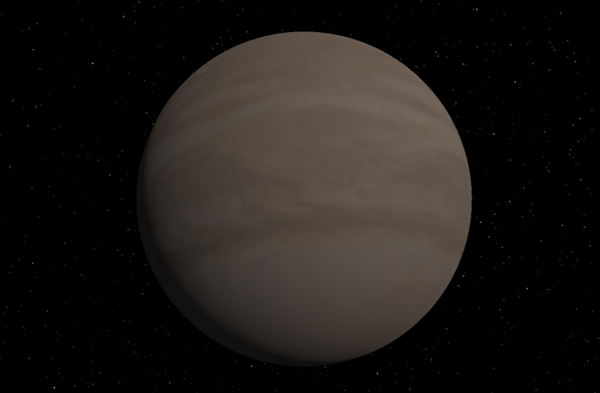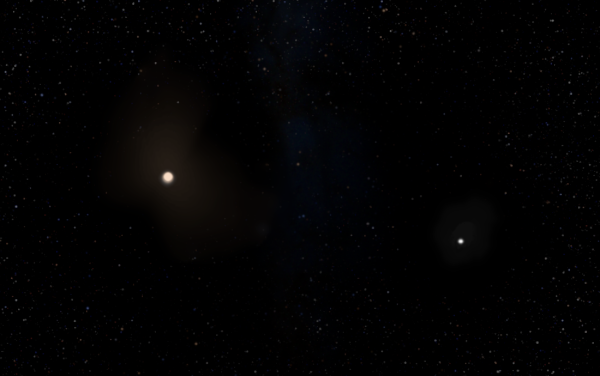BY LETTER
Kounzu Faashi (Nu Octantis)
Galactography > Regions of Space > Inner Sphere
Galactography > Systems and Worlds > Systems & Worlds K - L
Galactography > Systems and Worlds > Systems & Worlds K - L
 Image from Steve Bowers | |
| Saiygdja, the sole gas giant in this compact system, in a resonant orbit with the white dwarf. | |
Kounzu Faashi System - Data Panel | |
| System | Name: Kounzu Faashi Components: 2 1) Ohunma Apong (Nu Octantis A) 2) Conwisa (Nu Octantis B) Location: - Distance from Sol: 63.31 ly (J2000) - Constellation: Octans |
|---|---|
| Ohunma Apong | Names: Ohunma Apong, Nu Octantis A, GJ 835.1 A, GJ 9744 A, HD 205478 A, HIP 107089 A, HR 8254 A Physical characteristics: - Mass: 1.61 x Sol - Radius: 5.81 x Sol - Luminosity: 17.0 x Sol (bolometric) - Temperature: 4,860 Kelvin - Spectral type: K1 III (orange giant) - Rotation period: 140 days - Age: 2.8 billion years |
| Planet | Saiygdja: AithaliJovian HydrogeoBarian Semi-major axis = 1.3 AU, orbital period = 1.143 years, eccentricity = 0.12, mass = 2.4 x Jupiter, radius = 11.45 x Earth |
| Conwisa | Names: Conwisa, Nu Octantis B, GJ 835.1 B, GJ 9744 B, HD 205478 B, HIP 107089 B, HR 8254 B Physical characteristics: - Mass: 0.55 x Sol - Radius: 9,046.7 km - Spectral type: D - white dwarf - Age: 2.8 billion years System: The environs of Conwisa are largely empty, save for a number of asteroidal objects. |
| Binary orbit | The separation between Nu Octans A and Nu Octans B: Orbital characteristics: - Average separation: 2.6 AU - Orbital period: 2.8750 years - Eccentricity: 0.2359 System: A tenuous debris disk encircles around the two stars. |
 Image from Steve Bowers | |
| Nu Octantis A is an orange giant star, 17 x as luminous as Sol; Nu Octantis B is a white dwarf. A single planet (Saiygdja) remains in the system, in resonance with the white dwarf. | |
The Kounzu Faashi system consists of an orange dwarf star and a white dwarf in a relatively close orbit; this system contains a relatively large planet, the gas giant Saiygdja. This world is locked in mean-motion resonance with the white dwarf star Conwisa, the former completing five retrograde orbits in the time it takes for the latter to make two orbits, permitting it to survive the perturbation of the companion.
This system was first reached in 2096 AT by the autonomous exploration craft Waryu, and was first colonised during the Age of Expansion. Apart from the massive gas giant, this system had few easlily available resources, so the population was relatively small in number at first. During the formation of the white dwarf this system had been subject to very strong outgassing from the dying star, and this affected the composition of the atmosphere of Saiygdja. Using atmospheric extraction technology, the inhabitants of this system were able to construct an array of rotating space habitats.
The Uncontents
One unusual development that emerged in this system during the Consolidation Era was the Uncontents, a collective term for cultures and ideologies that trace back to the Cult of Uncontentment, a dystheistic and cynical movement that may have been influenced by the sparse nature of the local system. The Uncontents believed that the Known Universe was a failed experiment by an unknown entity or group of entities, and that these entities were either no longer interested in the fate of the universe, or that they no longer had the capability to affect events inside their creation. In particular many Uncontents believed that the period of cosmic Inflation had accidentally or deliberately continued for too long, making the Known Universe relatively empty and doomed to an even emptier future.Some Uncontents believed that there may be better universes elsewhere in the multiverse, and that it may be possible to find such locations and migrate to them. Other Uncontents anticipated that eventually the Terragen civilisation might gain the capacity to create new and better universes of their own. A number of Uncontents migrated to virchworlds of their own makings, while others became godwatchers keeping track of the development of basement universes. Some rumors even suggest that the personalities of the Uncontents that merged into the highest archailects have influenced them into researching creation of universes with different laws of physics from the ril.
Appears in Topics
Development Notes
Text by The Astronomer
Additional material Steve Bowers
Initially published on 31 March 2022.
Intended to be a stub article for further expansion created for the purpose of clarifying the nature of the secondary stellar companion.
Additional material Steve Bowers
Initially published on 31 March 2022.
Intended to be a stub article for further expansion created for the purpose of clarifying the nature of the secondary stellar companion.
Additional Information
Star A
- https://ui.adsabs.harvard.edu/abs/2012ApJS..203...30F/abstract (Mass, radius, temperature)
- https://academic.oup.com/mnras/article/449/4/4428/1184256 (Rotation period)
- https://academic.oup.com/mnras/article/394/3/1695/1072315 (Age)
Star B
- https://arxiv.org/abs/2101.06844 suggests that the companion is a white dwarf
- https://arxiv.org/abs/1605.06720 (Mass, orbital properties)
- Radius is fictional, based on https://www.researchgate.net/figure/White-dwarf-Mass-radius-relationship-for-two-different-chemical-compositions-of-k-2_fig7_324845118
- https://ui.adsabs.harvard.edu/abs/2012ApJS..203...30F/abstract (Mass, radius, temperature)
- https://academic.oup.com/mnras/article/449/4/4428/1184256 (Rotation period)
- https://academic.oup.com/mnras/article/394/3/1695/1072315 (Age)
Star B
- https://arxiv.org/abs/2101.06844 suggests that the companion is a white dwarf
- https://arxiv.org/abs/1605.06720 (Mass, orbital properties)
- Radius is fictional, based on https://www.researchgate.net/figure/White-dwarf-Mass-radius-relationship-for-two-different-chemical-compositions-of-k-2_fig7_324845118






